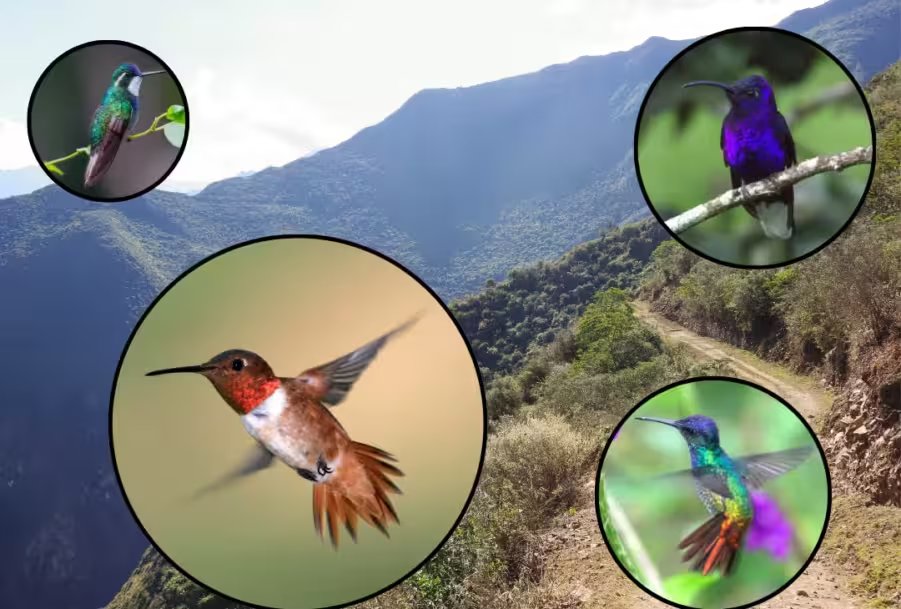Hummingbirds are among the most requested topics from readers, with questions like how do I make my own hummingbird nectar? and How do I attract hummingbirds to my yard?. All of that interest is no surprise! These fiery, energetic, and often colorful birds are always an exciting sight during outdoor excursions, and its about time they got more love from Gulo in Nature. In this post, let’s learn some of the wild facts about this bizarre and wonderful group of birds. Whether you’re looking to win your next trivia night or wow your friends with cool nature facts, this post should get you the range of hummingbird facts you need.
1. There are 366 described species of hummingbirds
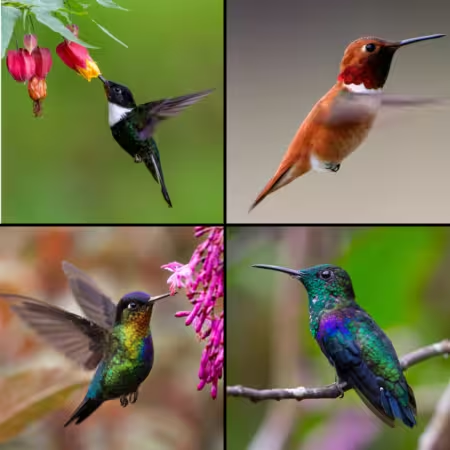
As it turns out, “hummingbird” actually describes a large number species. Ornithologists recognize more than three hundred extant (or living) hummingbird species on Earth today. That makes them one of the largest families of birds! Of course, all of hummingbirds have a lot in common: rapid wingbeats, “hovering” flight much like an insect, and a strong reliance on nectar and other sugary substances as a food source. Some parts of the world, like the Andes mountains, have a dazzling array of hummingbirds, many of different shapes and sizes. Meanwhile, places like the Eastern U.S. and Canada have only one! If you haven’t already, be sure to check out some field guides of the world’s birds to peruse these amazing “flying gems”.
Read more: The best field guides for North American birds
2. They all belong to one family: Trochilidae
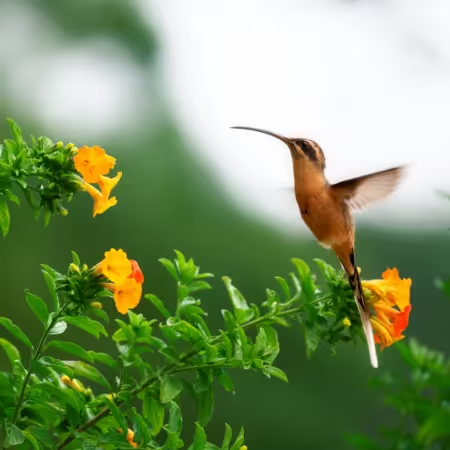
Believe it or not, all of those hundreds of hummingbird species belong to a single taxonomic family, the Trochilidae. Despite their differences, they are all closely related, and share a common ancestor that may have lived in ancient Europe. Within the hummingbird family, there are more closely related groups separated into Genera with cool names like:
- Woodstars
- Mangoes
- Hermits
- Coquettes
- Mountain-gems
- Brilliants
Read more: What is a ‘family’? How does taxonomy work?
3. Hummingbirds are only found in the Americas

Despite their suspected evolutionary origins, the hummingbirds of today only occur in North, South, and Central America. In North America, the majority of hummingbird species are found in the Western side of the country. While the ruby-throated hummingbird (Archilochus colubris) is a widespread and approachable hummer throughout the Eastern US and Canada, the West Coast and Rocky Mountains sport several more species. From the Southwestern US into Mexico, an even large number of species occurs. The highest hummingbird diversity can be found in the American tropics, especially ranging from the Amazon into the high Andes. While teaching field ecology in Central America, I’ve seen dozens of species of hummingbirds come to feeders while just having breakfast!
Unfortunately, this does mean that readers in Europe, Asia, Africa, and Oceania will have a long way to travel to see hummingbirds. Genuine hummingbirds don’t wander far from their home continents. However, some of their best imitators are found almost worldwide: see below!
Read more: How to attract hummingbirds to your yard
4. They have insect look-a-likes
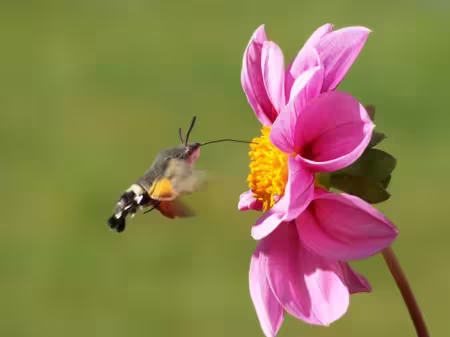
During Summer months, I occasionally hear from friends and readers about seeing “baby hummingbirds” in their garden. People describe seeing tiny, brown or green, hummingbird-like critters zooming around and eating nectar just like a hummingbird. I always encourage them to look again! Hummingbirds, like songbirds, have altricial young, meaning that their babies cannot fly until fully grown. So you won’t expect to find baby hummingbirds buzzing about all on their own. Instead, these are actually cool insects in the genus Hemaris, also known as hummingbird moths.
Hummingbird moths are active during the day (they are diurnal) and feed and behave much like hummingbirds. Unlike hummingbirds, they’re found well beyond the Americas. I captured some video of one that my friends encountered on a hike in Slovenia in Summer 2024. Check it out below!
5. Hummingbirds need to eat about 3 times their body weight in nectar per day
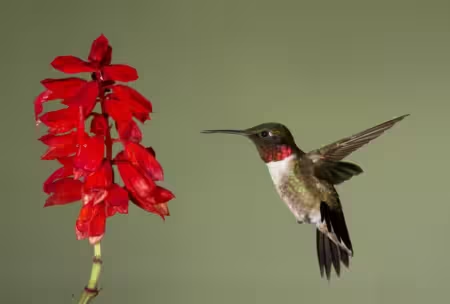
Coming across a hummingbird in the wild, one of the first things that people notice is their speed and activity. Hummingbirds are almost always on the move, zooming around at high speeds and visiting flowers for food. Their acrobatic and high-speed antics can be very entertaining to watch! Many hummingbird species are also highly territorial, fighting often to protect key nectar resources. All this fast-paced living comes at a cost, however: hummingbirds need a lot of energy to fuel that resource-intensive lifestyle.
In fact, hummingbirds actually have the fastest metabolism of any warm-blooded animal, making it necessary for them to almost constantly be feeding. During flight, hummingbird hearts may beat up to 1,200 times a minute; that’s ten times faster than a person while exercising! The result of all this intensity? most hummingbirds have to consume around three times their body weight in nectar per day. While a hummingbird doesn’t weigh much, that’s still a huge amount of nectar!
How to make your own hummingbird nectar
6. Among all bird families, hummingbirds have the most colorful males

Flip through the pages of any field guide to birds and it’s easy to find dazzling colors. Birds like parrots, new-world warblers, rollers, orioles, and many others bring vibrant colors to the animal kingdom. As you might imagine, hummingbirds are no slouch in the color department. Like many birds, males are the ones bringing the flamboyant fashion choices, and male hummingbirds may do this better than any other bird group. A 2022 study quantifying the color patterns and shades of more than 100 species of hummingbirds found that they cover a large proportion of all possible visual colors than any other group of birds.
7. When flying, they can flap up to 80 times per second!
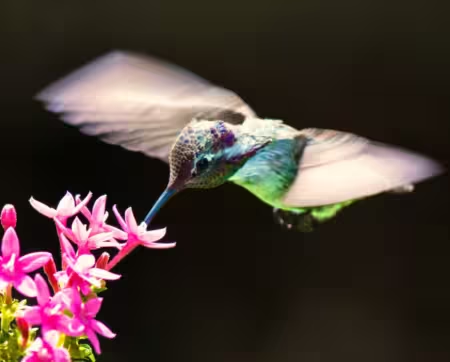
Hummingbirds get their name for their unusual flying mechanics, which let them perform helicopter-like acrobatics. Unlike most other birds, hummingbirds can stop on a dime to hover and fly backwards or straight up with little trouble. The rapid movement of their wings, which sounds like a giant insect, produces the unique “hum” by which they are known. Of course, flying like a bug is a lot of work! As they zoom about living their high-powered lives, hummingbirds “flap” their wings as much as 80 times per second. Although they don’t necessarily flap the way that larger birds do, these movements happen incredibly fast and produce that unusual locomotion.
8. Hummingbird tongues have microscopic structures that “unzip” and pump nectar into their mouth

For many years, naturalists and scientists believed that hummingbirds’ long tongues allowed them to simply lap up nectar as they drank from flowers. Just like bees, butterflies, and other pollinators, hummingbirds need specialized mouthparts to gulp down the large quantities of sugary nectar that they need to survive. However, scientists recently reassessed and discovered just how fancy that equipment is.
Working with hydraulics engineers, biologists at the University of Connecticut realized that hummingbirds drink too quickly to just be lapping up nectar by capillary action alone. Water can’t move that fast on its own! By studying hummingbirds in a laboratory using highly detailed slow motion photography, they found that hummingbird tongues actually act as pumps! Microscopic structures in the tongue expand and contract when the bird’s tongue moves in and out of a flower, pumping fluid back into their mouth. What an incredible feat of engineering!
9. The smallest living bird species is a hummingbird
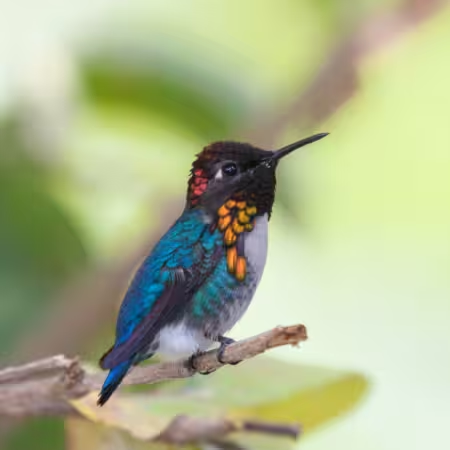
As you might have gathered from their high-intensity lifestyles, hummingbirds are animals of extremes. Their rapid, insect-like flight and persistence on nectar work better for small animals, and hummingbirds are indeed very small. For example, Ruby-throated hummingbirds, one of the most widespread species in North America, weigh about as much as a nickel (~5g), sometimes less. However, the smallest hummingbird species weighs even less.
The bee hummingbird (Mellisuga helenae), a miniscule hummingbird found only in Cuba, is the smallest living bird species. The larger females weigh about as much as a penny (2.5g) while adult males weigh slightly less than that, around 0.71 ounces or 2grams!
Read more: What bird has the largest wingspan on Earth?
10. Hummingbirds go into torpor to conserve energy night
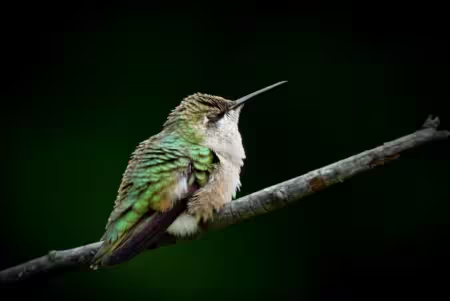
Given their quick metabolism and huge intake of nectar, hummingbirds have to be feeding constantly to keep themselves running. This means that an adult hummingbird needs a nectar meal just about every 10-15 minutes to survive. So how do hummingbirds get any sleep, and not spend all their time super hungry?
As it turns out, they use an adaptation much like what many other animals use to get through harsh winters. They go into a state called torpor, where their metabolism and heartbeat slow down. Because of this slowed metabolism, they burn less energy than when they’re “awake”, and can go through several hours without needing to eat. This is similar to a bear going into hibernation for several months when food supplies get low during the colder months. However, in the case of hummingbirds, they have to “hibernate” every night!
Read more: How do plants and animals survive the winter?
11. Their closest cousins are “nature’s fighter jets”
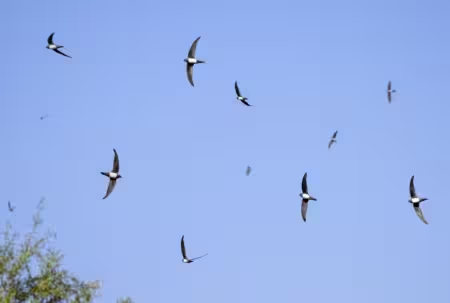
Although they stand out in their very own family, hummingbirds are not complete black sheep among the birds of the world. Their closest relatives belong to another weird and fantastic group of birds, the swifts (family Apodidae) and treeswifts (family Hemiprocnidae). Just like hummingbirds, these animals are absolute speedsters, although they don’t fly the same way. However, rather than fly like quick helicopters, these birds are more like fighter jets.
Swifts and treeswifts shoot through the air, zooming and banking as they chase down insects in the air column. Zipping around at 70 miles per hour (112 km/h) is an everyday thing for most swifts, and their maneuverability is legendary. One entire genus of swifts is called “Aeronautes“, suggesting their reputation as constant and expert fliers.
12. Some male hummingbirds have musical tails

Male birds are often more colorful in order to advertise to, and attract, potential mates. As you read above, male hummingbirds are the most colorful in the world. However, that’s not the only aspect of their game. Many species also try to woo females with elaborate courtship displays that show off their speed and agility in the air. Rather than complement these sky-dances within singing, these males use specially designed tail-feathers to get a sound component to their performance.
Read more: why do people find birdsong so relaxing?
Although hummingbirds can vocalize, their voices are pretty limited to twitters, squeaks, and chirps; beautiful songs aren’t so common. The sounds that these special tail feathers make, however, can sound like a voice all on its own! These tail feathers produce sound similarly to the reed in a woodwind instrument. When air passes over them in the right direction and with the right speed, it produces a vibration that makes a specially tuned sound.
I found this out myself while studying woodpeckers in the foothills of the Sierra. As I got out of my truck one morning, I kept hearing a high-pitched, short whistle, and didn’t recognize it as any familiar birdcall. So I followed the sound, and eventually found myself in a grassy clearing at the edge of some woods. Perched at the top of a tall shrub was a female Anna’s hummingbird (Calypte anna) sitting calmly and occasionally grooming herself.
I stared at the little hummingbird trying to see if she was making the noise, when suddenly what looked like a self-guided bullet zoomed past her in a blur with a loud “cheep!”. The object then rose sharply and flew high in the air, and when I managed to find it I could see it was a male. He would hover perhaps 40-80 feet (12-24m) in the air, then dive down toward the resting female. Pulling up at the last minute, he would spread his tailfeathers, some of which would produce the whistling sound, before zooming back up into the sky again. To this day, one of the coolest behaviors I’ve ever seen in the wild!
Sources and further reading
Rico-Guevara, A., and Rubega, M.A. 2011. The hummingbird tongue is a fluid trap, not a capillary tube. Proceedings of the National Academy of Sciences.
Rico-Guevara, A., Fan, T.-H., and Rubega, M.A. 2015. Hummingbird tongues are elastic micropumps. Proceedings of the Royal Society B: Biological Sciences.
Thanks for reading Gulo in Nature’s hummingbird facts!
If you enjoyed this post, please support the blog by sharing this post with friends and following the blog on Social Media. If you have a post that you’d love to see, get in touch using the Contact Page. Until next time, go get to know your natural world!

